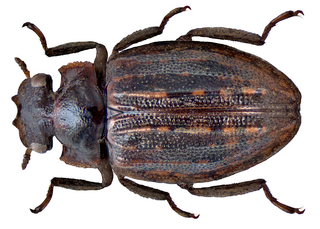
Spercheus is a genus of aquatic beetles which are placed in a family of their own, Spercheidae. About 20 species are known from around the world, with the majority being from the Oriental and Afrotropical Realms.

Darkling beetle is the common name of the large family of beetles Tenebrionidae. The number of species in the Tenebrionidae is estimated at more than 20,000 and the family is cosmopolitan in distribution.

The Dytiscidae – based on the Greek dytikos (δυτικός), "able to dive" – are the predaceous diving beetles, a family of water beetles. They occur in virtually any freshwater habitat around the world, but a few species live among leaf litter. The adults of most are between 1 and 2.5 cm (0.4–1.0 in) long, though much variation is seen between species. The European Dytiscus latissimus and Brazilian Megadytes ducalis are the largest, reaching up to 4.5 cm (1.8 in) and 4.75 cm (1.9 in) respectively. In contrast, the smallest is likely the Australian Limbodessus atypicali of subterranean waters, which only is about 0.9 mm (0.035 in) long. Most are dark brown, blackish, or dark olive in color with golden highlights in some subfamilies. The larvae are commonly known as water tigers due to their voracious appetite. They have short, but sharp mandibles and immediately upon biting, they deliver digestive enzymes into prey to suck their liquefied remains. The family includes more than 4,000 described species in numerous genera.

Pimelia is a genus of darkling beetles in the subfamily Pimeliinae.

Glaphyridae is a family of beetles, commonly known as bumble bee scarab beetles. There are eight extant genera with about 80 species distributed worldwide and two extinct genera described from the Aptian aged Yixian Formation of China. There are cases of flower-beetle interactions, in the southeast Mediterranean region between red bowl-shaped flowers and Glaphyridae beetles.

Monochamus is a genus of longhorn beetles found throughout the world. They are commonly known as sawyer beetles or sawyers, as their larvae bore into dead or dying trees, especially conifers such as pines. They are the type genus of the Monochamini, a tribe in the huge long-horned beetle subfamily Lamiinae, but typically included in the Lamiini today.

The minute tree-fungus beetles, family Ciidae, are a sizeable group of beetles which inhabit Polyporales bracket fungi or coarse woody debris. Most numerous in warmer regions, they are nonetheless widespread and a considerable number of species occur as far polewards as Scandinavia for example.
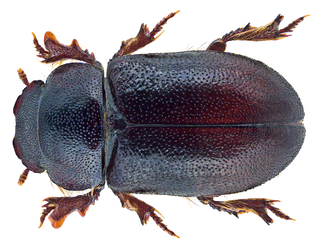
Cheirodes is a genus of darkling beetles in the Melanimini tribe. It was formerly known as Anemia until 1973, when T. J. Spilman determined Anemia to be a synonym of CheirodesGéné, 1839.
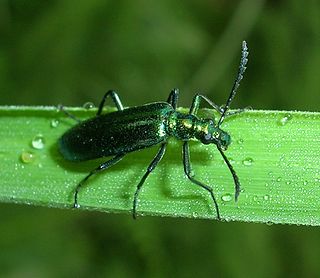
Prionoceridae is a small family of beetles, in the suborder Polyphaga. They form a group within the cleroid beetles and were formerly treated as a subfamily (Prionocerinae) within the family Melyridae. Very little is known of their life history but most species are pollen feeders as adults and occur in large numbers during spring or the host flowering season. Larvae are predatory or feed on decomposing wood.
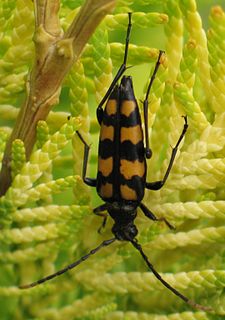
Leptura is a genus of beetles in the family Cerambycidae, containing the following species:

Gonocephalum is a genus of darkling beetles in the family Tenebrionidae.

Epicauta is a genus of beetles in the blister beetle family, Meloidae. The genus was first scientifically described in 1834 by Pierre François Marie Auguste Dejean. Epicauta is distributed nearly worldwide, with species native to all continents except Australia and Antarctica. Surveys have found the genus to be particularly diverse in northern Arizona in the United States. Few species occur in the Arctic, with none farther north than the southern Northwest Territory of Canada.

The Sepidiini is a tribe of ground-dwelling darkling beetles (Tenebrionidae), that occurs across Africa, the Mediterranean Basin, the Arabian Peninsula and Mesopotamia. It is composed of many hundreds of species. The larvae of some species are known to damage crops.

Coptops is a genus of longhorn beetles of the subfamily Lamiinae, containing the following species:

Polyarthron pectinicorne is a species of beetle in the family Cerambycidae.

Tillinae is a subfamily of beetles in the family Cleridae, the checkered beetles.
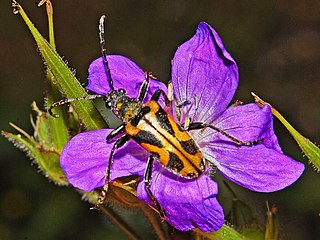
Brachyta is a genus of the Lepturinae subfamily in long-horned beetle family?

Pareuryomma is an extinct genus of Ommatine beetle. It is known from three species, P. angustum, P. cardiobasis and P. tylodes, all known from the Aptian aged Yixian Formation of China. The genus was first described in 2012, and formerly included the species Pareuryomma ancistrodonta from the Middle Jurassic Jiulongshan Formation, China, which was transferred to the genus Omma in 2020. The species P. angustum was formerly thought to be part of Brochocoleus. The genus is characterised by "slender body, long and subparallelsided or slightly narrowed head with moderately prominent eyes and more or less prominent temples, narrow pronotum with more or less explanate lateral carinae, elytra with the veins more or less well expressed and independently ending on Sc, large cells more or less arranged in rows on disc and moderately widely explanate sides of the elytra, and abdominal ventrites co-planar."
Burmese amber is fossil resin dating to the early Late Cretaceous Cenomanian age recovered from deposits in the Hukawng Valley of northern Myanmar. It is known for being one of the most diverse Cretaceous age amber paleobiotas, containing rich arthropod fossils, along with uncommon vertebrate fossils and even rare marine inclusions. A mostly complete list of all taxa described up until 2018 can be found in Ross 2018; its supplement Ross 2019b covers most of 2019.


















